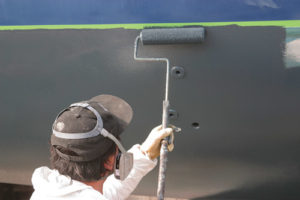
Choosing bottom paint has become a rather complex subject as a result of environmental issues, modern chemistry, usage characterizes, and the conditions of your local waters. We have noticed a distinct difference in growth on boats in Red Brook Harbor verses those in West Falmouth Harbor, for example. Differences in the speed boats travel and how often they are used should also be factored into the decision.
Until recently, bottom paints could be broken into two basic categories: Hard, or contact leaching paints dry to a porous film that is loaded with biocides. These biocides leach out of the paint over the course of the season, killing and preventing growth on your boat’s bottom. Once the biocide is all gone, or when the bottom dries out such as being hauled for the season, the remaining paint remains intact but has no more antifouling capability. Hard paints have the advantage of being resistant to rubbing and abrasion, and they can be sanded to reduce drag and make the boat faster.
Ablative paints wear away and erode as they pass through the water, providing an unstable surface for marine growth and delivering biocides more efficiently than hard paints. There are several types of ablative paints, but all wear away either through chemical reactions or the physical action of the water over the surface of the bottom. These paints work best in high growth waters and, for the mast part, their longevity is related to how thickly the paint is applied.
The new SLIPS paints will come to market this season, essentially a combination of traditional hard and ablative bottom treatments. These fully-slippery, liquid-infused surfaces are designed to maintain a stable and immobilized thin liquid film on the surface. This liquid over-layer is what makes a SLIPS surface provide a true liquid-to-liquid interface and “feel” extremely slippery to marine fouling agents so they can’t hold on to SLIPS. Our own testing of SLIPS on the Kingman Launch last summer, as well as field studies in other marine environments, show SLIPS to be an effective alternative to the toxic copper-based anti-fouling paints and to the more expensive foul-release coatings.
We will carry SLIPS as soon as it becomes commercially available, and we sell all major marine brands of paint. Interlux and Pettit brands have been the most popular. They have single-year ablative paints in water base and oil base, they offer several varieties of multi-year paints, and now offer more environmentally friendly, copper-free antifouling paints.
We are available to discuss the merits of any and all brands and types of paints and would be happy to make recommendations as to which paint might be the best long-term value for your boat. If you are considering a different paint from seasons past please call to check for compatibility as additional preparation may be required. If you’d like to do some research on your own, consider the following links to manufacturers offering
specialized paint selector guides.
Interlux: http://www.yachtpaint.com/usa/diy/products/antifouling/search.aspx
Pettit: http://www.pettitpaint.com/products/antifouling-bottom-paint/
Interlux has an an app for smartphones and tablets to help you find the right paint for your boat. The free app is available on the Apple App Store and on Google Play, and even includes a paint calculator to estimate how much paint you’ll need for your boat.
Choosing the right paint is only half the battle of course. If the surface has not been prepared properly you simply won’t get the finish desired. Have a read through our Marine Abrasive Product Guide before even thinking about your paint requirements!